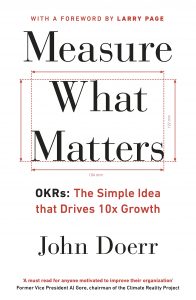
Basic definition of OKR
- Objective- what is target
- KRs- defined with a number and a timeline
- If OKRs were designed wellWhen all KRs are met objective should have been achieved.
Why are OKRs powerful
- OKRs surface your primary goals.
- Channel efforts and coordination.
- Link diverse operations .
- Bring purpose and unity to the entire organization.
Accompanying Research
- 2009 HBS – goals gone wild- Note to self – read this paper
- Edwin Locke – hard goals drive performance. Specific hard goals produce higher levels of output
Google’s early years, Larry would spend 2 days each qtr reading and scrutinizing each sw engineers OKRs. And start each qtr with leadership team objectives.
Superpowers
1. Focus and commit to priorities
2. Align and connect for teamwork
3. Track for accountability
4. Stretch for amazing
Fairchild vs Intel – effectiveness in translating knowledge into actual results. Amazing story about how a note from a front-end sales rep trigerred the largest transformation in Intel’s history. And how OKR was the bedrock that delivered this company wide accelerated transformation.
Output vs activity
OKR hygiene list by Andy Grove:
– Less is more . Limit to 3-5
– Set goals from bottoms up
– No dictating
– Stay flexible
– Dare to fail. Stretch goals. Aspirational OKR
– A tool not a weapon. Not link bonus
-Be patient, be resolute. 4-5 qtrly cycles of OKRs to get it.
Intel was great at Declaring great generalizations and translating them into actionable coordinated programs.
Pair OKRs with counter balances. Eg vouchers processed with number of errors. Quantity and a quality goal.
Key results should be succinct specific and measurable. Mix of outputs and Inputs. Completion of all KRs must result in attainment of goal. If not it’s not an OKR.
Continuous performance management via CFR ie conversations, feedback and recognition.
Decouple compensation and raises/promotions from OKRs as the comp discussion is backward looking and OKRs are forward looking.
# Key Takeaways:
– The importance of setting and tracking measurable goals in order to achieve success
– The use of Objectives and Key Results (OKRs) as a framework for goal-setting and tracking progress
– The need for alignment and transparency in goal-setting and communication within an organization
– The role of leadership in driving the implementation and success of OKRs
# Practical Application:
– Identify and define clear and measurable objectives for your team or organization
– Use the OKR framework to set and track progress towards these objectives
– Foster a culture of transparency and alignment within your team or organization
– Lead by example and actively participate in the implementation and tracking of OKRs
# Valuable Insights:
– Chapter 2: “The Art of the OKR” provides a detailed explanation of the OKR framework and its components
– Chapter 5: “Alignment: The Key to Unlocking the Full Potential of OKRs” emphasizes the importance of alignment and transparency in goal-setting and communication
– Chapter 8: “The Role of Leadership in OKRs” highlights the crucial role of leadership in driving the success of OKRs within an organization
# Case Studies and Examples:
– Google’s use of OKRs to drive their growth and success
– The implementation of OKRs at Intel and how it transformed the company’s performance
– The use of OKRs by the Gates Foundation to effectively measure and achieve their philanthropic goals
Leave a Reply